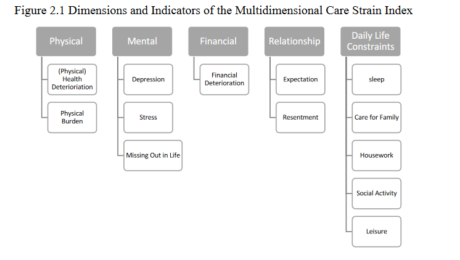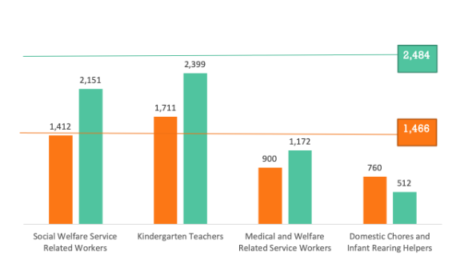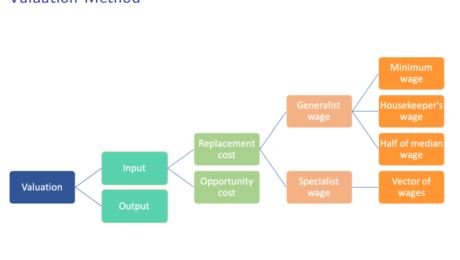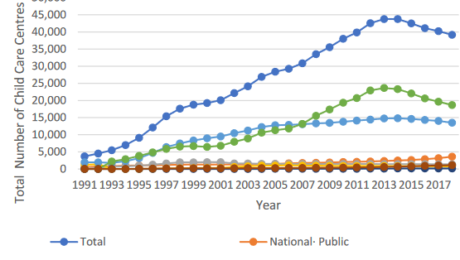Measuring the Overall Strain of Caregiving: A Multidimensional Approach
Providing care for others, especially for the frail elderly and young children, is one of the most important forms of human work that sustains our existence. However, caregiving is also often challenging and strenuous. Many informal caregivers are known to suffer negative physical, emotional, and social outcomes, and are at risk of losing their own health and well-being. Fengler and Goodrich, for example, refer to the wives of frail elderly men as ‘the hidden patient,’ warning the negative consequences of caregiving on informal caregivers. Since the 1980s, several instruments have been developed to measure the strain of caregiving among informal caregivers. Some measurements such as the Zarit Burden Interview and the Caregiver Strain Index have been applied more widely, while other measurements have been used for more specific groups of caregivers (e.g., who takes care of the elderly with cancer). Although these measures provide valuable information on various dimensions of caregiver strain, they are not sufficient to assess the overall level of strain experienced by caregivers. In most cases, these measurements consist of a list of questions or statements about the caregiver’s burden; the sum of the answers is then used to indicate the level of burden/strain experienced by the caregiver. Although useful, a simple non-weighted sum of answers may not be an accurate representation of the overall strain. For instance, two groups of caregivers may have the same average total strain score, but one group may consist of all caregivers who suffer strain in some statements, while the other group may have half of the care givers who suffer strain in all statements and the other half who do not suffer strain at all. While the marginal distribution may be the same, the joint distribution may not, and this has an important policy implication.
Adapting the Alkire-Foster method developed to measure multidimensional poverty, Jun et al (2019) propose a threshold-based approach to measuring overall caregiving strain that accounts for the multidimensionality of the caregiving experience. The approach is based on the premise that as in the case of poverty, the negative consequences of multiple strains attached to caregiving would be greater than the sum of their individual effects. The authors first identify the dimensions and indicators that are known to be important consequences of caregiving, such as physical, psychological, financial and relational strains, and daily life constraints. They then count the overlapping strains a care giver experiences under different indicators of caregiver strain. Next, they identify caregivers who are experiencing strains above a specific cut-off point as multi-dimensionally strained. This measure is tested using the data from the newly collected Survey of Eldercare and Childcare in Korea 2018, exploring whether receiving support, help and appreciation may be associated with reduced chance of being multi-dimensionally strained. By providing an overall measurement that identifies caregivers with multiple strains, the authors examine 1) which group of caregivers are more likely to be at risk; 2) which dimensions do most caregivers suffer strain; and 3) what may be potential buffers for caregiving strain.
This paper will be available December 2019
This blog was authored by Jiweon Jun, Ki-Soo Eun and Ito Peng
- Published in South Korea, Understanding and Measuring Care
Methodology for Estimating the Paid Care Sector in South Korea
Care work, whether unpaid or paid, lies at the heart of humanitarian concern and expression, and our societies and economies are dependent on it to survive and thrive. Across the world, women account for more than three-quarters of the total amount of unpaid care time while two-thirds of paid care workers are women (Folbre et al. 2012; ILO 2018; Yoon et al. 2011).The outsized role that women play in providing care is readily observed in South Korea, with its strong patriarchal and familistic orientation that assigns primary responsibility for the care of children and elderly to women in the household, reinforcing the economic significance of gender. While unpaid care work by family members, especially women, makes up a large part of the care provided within Korean society, the rapid aging of the population and the fact that more than 50% of the female population aged 16 and older participated in the labor force in 2016-18 underscore the importance of paid care workers in meeting care needs(ILO 2018).They tend to the most basic necessities and help sustain the well-being of those in dependent positions, such as children, frail elderly, or people with illness and/or disabilities. Broadly, there is a spectrum of paid workers providing care, ranging from informal workers such as domestic service workers, nannies, and home care aides in private homes to formal workers in child care centers, nurseries and early childhood learning centers, elder care centers, nursing homes, and assisted living facilities, to nurses and teachers.
Accounting for the contribution of paid care workers is crucial to our understanding of the centrality of care in the development of human capabilities and economic progress; itis a crucial part of the effort to make women’s work and all forms of care work more visible. As the ILO (2018) points out, “care workers close the circle between unpaid care provision and paid work” (p.166). It is also critical to understand their work conditions since they represent one of 5the fastest growing segments of the labor force. For that reason, it is of particular concern that the paid care workforce experience slow wages and difficult working conditions across occupations and industries (ILO 2018). For instance, domestic workers are most vulnerable to exploitation and abuse among all workers in the labor market (UNDP 2015), a consequence of their frequent exclusion from laws and regulations affording labor protections. Understanding paid care work is therefore critical to shedding light on the implications of economic, cultural, and policy contexts that shape the larger labor market as well.
Suh (2019) provides a comprehensive picture of the paid care workforce in South Korea by measuring its size and extrapolating the median wage earnings and aggregate hours spent on care-giving by the workers using following data sources: the Local Area Labor Force Survey, Child Care Statistics, Social Services Voucher Statistics, and Long-term Care Insurance Statistical Yearbook for 2009 and 2014. The size of the paid care workforce in South Korea in this estimation focuses on the value of the labor provided by care workers that are directly and indirectly involved in elder care and childcare provision. The estimation will be used for making the paid care sector visible in the Korean Social Accounting Matrix (SAM), which serves as the base for developing the GAM Care Computable General Equilibrium (CGE) model for policy analysis.
This paper will be available December 2019
- Published in South Korea, Understanding and Measuring Care
Methodology for Estimating the Unpaid Care Sector in South Korea
Mainstream economists continue to define economic growth in terms of conventional measures such as market employment and income per capita. Women’s taking on full-time employment outside the home, therefore, has stimulated Gross Domestic Product (GDP) growth, while the social cost of a shift from informal to the formal economy has been ignored. The importance of fully recognizing the economic contributions of all forms of work –paid and unpaid–as a precondition for achieving gender equality has been proposed by feminist researchers since 1980s (Waring 1988, Folbre 1991). They have emphasized the need for empirical analysis of time devoted to unpaid care work, especially direct care of children, adults in need of assistance because of illness or disability, and the frail elderly.
Unpaid care work, i.e. household production, is the most significant part of production which is excluded from the production boundary of the system of national accounts(SNA) and hence, from the most commonly used economic indicator, Gross Domestic Product (GDP). The failure to recognize the economic value of unpaid care work leads to the belief that people who, without compensation, devote time to caring for others are unproductive or inactive and their unpaid activities fall outside the business of economic life. To be sure, unpaid household services and care work are now recognized in the landmark resolution for defining and measuring work passed during the 19th International Conference of Labour Statisticians (ICLS) in 2013. Nevertheless, the lack of recognition of unpaid care work in the national accounts hinders the promotion of gender equality at the macroeconomic level due to the importance of these accounts as instruments for policymaking.
Suh (2019) first explores the concept of unpaid care work and its two forms, direct or relational care activities and indirect care activities. It then examines the role of time use data in estimating the unpaid, direct or relational care labor time provided by household members and the various methods by which this form of unpaid care work can be measured and valued, highlighting methodological and measurement issues. The input-based approach is then applied to the estimation of the imputed value of unpaid care provided by women and men aged 18 years and older based on the national Korean time use survey data and the Korean Labor Force survey for 2009and 2014. A range of wage rates is used for the estimation and differences between women and men are highlighted. These estimates are then aggregated for the population of South Korea. Finally, the paper concludes with a brief commentary on the importance of measuring and valuing unpaid care work.
This paper will be available December 2019
- Published in South Korea, Understanding and Measuring Care
An Overview of Care Policies and the Status of Care Workers in South Korea
The last couple of decades have seen a dramatic transformation of the care infrastructure in South Korea. This is evident from the introductions of successive government policies and programs to socialize care and to address the issue of work-family balance. These new policies and programs have resulted in a steady expansion of publicly funded and publicly or privately provided care services for children and the elderly, financial support for families with young children, and family support programs such as maternity and parental leaves and family care leaves. Although there has been a significant amount of research on child and elder care policies in Korea, not as much attention has been paid to the status of care workers. This is unfortunate particularly given that social care expansion in Korea has been one of the most important drivers of employment growth in the country for the last decade and a half.
Peng et al (2019) provide an overview of care policies in South Korea and their developments since 2000 and discuss the status of care workers in the context of the current care infrastructure. They focus on paid childcare and elderly care as much of the country’s current care policies are directed to these two sectors. A broad overview outlines the current care policies and systems, including some data on the number of people who are affected and serviced, and some of the immediate causes of the government’s policy focus on care and of social care expansions and reforms. Recent developments in Korea’s care policies illustrate a path of progressive and successful socialization of care that has yielded a significant employment generation, particularly for women. Despite the progress in social care, however, available data suggest that the working conditions and status of care workers in Korea are not very positive: women dominate care work in both child care and elder care, and care workers are largely poorly paid, over-worked, and their employment is precarious. Care work is also accorded with low social and occupational status, and many care workers experience significant social and emotional stress.
The authors conclude by discussing the implications of South Korea’s current care infrastructure for gender equality and the care economy. To better understand the nature of care work and the status and situations of care workers, and Korea’s care infrastructure, they call for more in-depth data collection on care workers as well as more comprehensive measures of care
This paper will be available December 2019
- Published in South Korea, Understanding and Measuring Care
Policy Analysis in a Macroeconomic Model of Social Reproduction
Since the 1990s, unpaid work and care have garnered increasing academic attention, creating the emerging fields of the economics of unpaid work and the study of “the care economy.” Most of the earlier work was oriented toward microeconomics, focusing on issues such as the household division of labor, subsistence production in developing countries, the substitution between non-market and market goods and services in households, and the role of caring motivations in sectors of the labor market in developed and developing countries. Empirical work paralleled these theoretical efforts. Examples include measuring unpaid work via time-use surveys across the world, estimating the monetary value or opportunity cost of unpaid work, and linking care with the gender–wage gap and gendered job segregation. Macroeconomic models exploring gender and economic development were rare, and even fewer macro studies examined care and unpaid work.
Braunstein et al. (2011) contributed to this literature by embedding unpaid work and care in a structuralist macro model, illustrating how the social structures of production matter for economic outcomes. Braunstein and Tavani (2019) recast a simplified version this model in order to generate policy implications through numerical simulation. The authors go beyond the standard utilization-labor share framing in structuralist models in order to focus on more direct measures of gender inequality and the gender composition of the labor force and of employment. The resulting producer’s equilibrium – which describes the supply side of the model – always features a positive relationship between economic activity and gender wage equality. The goods market equilibrium, or the investment-savings curve, can either be care-led or inequality-led. The model results accommodate a variety of scenarios. A reduction in non-market care time can foster both aggregate demand and gender equality, but under some conditions it is also possible that there are trade-offs between economic activity and gender equality.
This paper will be available in December 2019.
Informal Caregiving, Family Power Dynamics, and Labor Market Rigidities
A growing concern in many countries is an aging population and an increase in the number of elderly in need of long-term care (LTC). However, the economic and welfare implications of LTC provision remain relatively understudied. One of the primary factors which complicates welfare analysis is that a bulk of elderly care is provided by family members. Norton (2000) estimates that roughly two-thirds of LTC is provided informally. The pervasiveness of informal care due to cultural or family ties has even limited the development of LTC insurance in economically advanced regions like Europe (Costa-Font, 2010). Hence, in order to understand the full macroeconomic implications of growing LTC demands and the appropriate policy response, it is imperative to explore how households cope with these caregiving needs.
Informal caregiving is a time intensive task and must be met by adjustments along leisure or work margins on the part of the care provider. But do caregivers share the full burden of care with other members of their household? Standard cooperative models of the household suggest the welfare burden of care would be distributed across household members (e.g. husband and wife). However, existing literature shows that caregiving falls disproportionately on women as compared to men.
Miller and Bairoliya (2019) develop and calibrate a simple collective model of intra-household bargaining to analyze the time and resource allocation decisions associated with informal care. The authors show that a decrease in bargaining power increases one’s share of the welfare burden. If bargaining power is endogenously determined by relative earnings, the welfare cost of caregiving can fall disproportionately on a single partner, resulting in a “triple burden” of market work, home production, and caregiving. Labor market rigidities exacerbate the total welfare cost of informal caregiving to the household as well as the unequal distribution of the burden.
The paper will be available December 2019
- Published in Understanding and Measuring Care
Impact of Investing in Social Care on Employment Generation, Time- and Income-Poverty and Gender Gaps: A Macro-Micro Policy Simulation for Turkey
CONTRIBUTORS
İpek İlkkaracan, EMEL MEMIS, KIJONG KIM, TOM MASTERSON, and Ajit Zacharias
Feminist economists have long emphasized the recognition, reduction and redistribution of unpaid care work (the so-called 3R strategy) as a primary policy intervention towards closing of the gender economic gaps. Investing in a social care infrastructure is an important component of the 3R strategy. Universal access to quality care services enables reduction of the unpaid work burden through its redistribution from the domestic sphere to the public sphere. Public investment and expenditure, however, is a question of fiscal policy at the helm of macroeconomists and policy-makers who are often gender blind and also adopt the mainstream approach of public expenditure constraint. Several waves of empirical research have examined the allocation of sectoral allocation of public expenditure through macro-micro simulations.
Yet until recently, studies have failed to explore an important outcome of investing in social care from a gender perspective, namely gendered patterns of time allocation. While investing in social care creates jobs for some women, enhances their access to employment and earnings, it also increases the requirements on their time through higher paid work hours. Simultaneous access to services alleviates the unpaid work burden of women with care dependent household members. The net welfare impact for different groups of women and men taking both time- and income-effects into consideration is an empirical question.
The forthcoming paper titled “Impact of Policy Interventions at Reduction and Redistribution of Unpaid Care Work On Employment Generation, Time- And Income-Poverty And Gender Gaps: A Macro-Micro Policy Simulation For Turkey” by Ilkkaracan, Kim, Masteron, Memis, and Zacharias uses an applied macro-micro simulation policy modelling approach to explore the gendered impact of increased public expenditures on social care service expansion on new employment and income generation, time allocation to paid versus unpaid work, time- and consumption poverty. An increase in social care spending triggers two types of effects at the household and individual level: It generates new jobs improving access of previously non-employed persons (predominantly women) to employment and income generation, but at the expense of increasing paid work time of job recipients. Simultaneously, improved access to childcare services reduces unpaid work time in the households with small children. The authors use a statistically matched data set from the 2015 Time Use Survey (TUS) and the Survey on Income and Living Conditions (SILC) in Turkey to assess the impacts on individual and household well-being, not only in terms of gains in employment and income, but also in terms of potential changes in household production responsibilities and time deficits.
The paper will be available December 2019
Current Policies and Programs Addressing Childcare and Eldercare in South Korea
South Korea has experienced rapid economic growth and accelerated industrialization and modernization within a relatively short period of time in the seventies and eighties (Jang, 2009). Social policies were heavily oriented in supporting the government’s development strategies in terms of increasing human capital and improving health through public investment in these sectors (Song, 2014). Through most of that period, families were encouraged to carry the entire burden of care work and childrearing responsibilities, and social policies played a minimal role in sharing this burden, being mainly targeted to very limited low-income groups. Furthermore, filial piety, called hyo, one of the Confucian ideologies that served as a dominant foundation of state philosophy before the modern era of South Korea, remained even after the establishment of modern government and functioned as an essential foothold in determining care responsibility, unloading it entirely to the family (Lee, 2017).
However, demographic shifts, government regime change, and democratization process highlighted the need to address issues of redistribution and welfare and the important role of the state. The concept of the state serving as the main care provider is now gaining more attention, with its importance highly underlined in the current era of low fertility rates and an aging population in South Korea. In response to increased social awareness and demands, the South Korean government has shown efforts to revalue care work and reach a range of families’ needs.
The major care policies that South Korea currently has in place are:
- the Early Childhood Education and Care Policy,
- the Long-Term Care Insurance (LTCI) Program,
- the Maternity Protection Act, and
- welfare policies for the disabled.
Gilbert and Neil (1974) in their book Dimensions of Social Welfare Policy introduced the idea that social provision can be divided into several types; power, cash, vouchers, time, services, and opportunity. The order of each type represents the degree of freedom of choice; for example, cash represents more freedom of choice compared to services. South Korea’s social and family policies have shown preference for expanding government provided care services, rather than developing social provision in the form of time or cash benefits. However, after recovering from economic crisis (1997-1998) and welfare reform (1999-2001), the Korean government has assumed greater responsibility by legislating, financing, and providing welfare, particularly childcare and elderly care, in public sectors, community level/local government sectors and also supporting the private care market sector. Promoting more care services supported the creation of more jobs in the care sector and allowed unpaid caregivers/housewives to enter labor force as paid careworkers.
South Korea’s social policy has gone through dramatic reforms recently, with the government moving its focus beyond the expansion of existing services towards creating policies (in the form of parental/emergency care leave as well as vouchers and allowances), which provide not only services but also financial support to households who take care of dependent family members on their own.
Currently the basic model for childcare in South Korea is to provide government-supported daycare (9:00 am to 4:00 pm) and education for all children from the ages of 0-6 years. When the model was first introduced, there were several blind spots and families’ needs were not always met. For example, early morning and late-night care (i.e. after 5:00 pm) was not provided. Korean society is notorious for long workhours for employed individuals, and the model doesn’t allow many dual-earner parents to both remain in full-time employment or the model requires them to find additional, often costly, care services. Over the last few years off-hours (7:00 am to 10:00 pm) care services were created and expanded to meet these unmet care needs. In addition, to prevent sole-care burden (“독박육아”, dok-bak-yook-a) among those who raise children alone at home, community-based childcare services for unpaid caregivers (e.g. housewives) were developed by local government subsidies. The prime objective of this service was to create a space for sharing childcare information within the community; engaging in education and entertainment together; and for lessening the burden of care, through services like childcare centers and co-parenting cafés.
Although the government (both central and local) expanded social policy significantly and provided huge amounts of subsidies for these services, several policymakers and researchers point out that parents or caregivers still feel burdened with care for their children and a great proportion of the expenses are still paid by the users.. For most social services, middle-class families are not eligible or only receive partial benefits since these programs mainly target low income families.
Even though the government has expanded social welfare programs since 2000, this was not in effect to impact the fertility rate. Therefore, the service-based childcare model has brought about discussion and debate in South Korea, as people tend to recognize that public services cannot meet the various needs of every family in the country. For example, for child care services, there has been debate on whether or not it is good for young children to stay 7-10 hours in a daycare center. Some scholars have also argued that there is a need to support caring for children “at home” or providing services in a “home-like” environment (Lee and Kim. 2011).
South Korea is also facing a “parental rights movement”, with advocates promoting family time and quality time for caring for children. Providing “time” for parents is the solution they feel will help parents the most. To provide higher flexibility for dual-earner parents who at the same time want to take care of their children by themselves, the government has pushed for a full year paid parental leave program. This was designed to give additional leave to parents who get 90 days maternity leave (fully paid) if they give birth. Both employed mothers and fathers can use full year parental leave until one child gets to age 9, respectively. This leave program guarantees about 50% of personal monthly income (although there is a ceiling for the income compensation). Although this full year parental leave program started in early 2000, it had been rarely practiced, as employers and sometimes even employees were reluctant to use it. However, to boost the low fertility rate, the government is now pushing for parents with young children to actually use this program. This is done by subsidizing (relieving company tax, spending direct financial funds), both in public sectors and private companies. According to labor statistics (2017) only 34,898 mothers and 502 fathers used parental leave in the year 2009, while, in 2017, the number of parents using the leave almost doubled for mothers (78,080) and increased dramatically for fathers (12,043).
In addition to parental leave policies, a financial benefit (age 0-5 years) starting from July 2018 will be provided to families with young children, with the eligibility set by their income level.
Compared to childcare, eldercare provision in South Korea has a shorter history. In 2008, the issue of eldercare gained greater attention, due in large part to the rapid growth of the elderly population and increase in life expectancies. A state-supported model of eldercare was developed as a result. The primary eldercare provision comes from long-term care insurance (LTCI), which allows all elderly with care needs access to non-live-in domiciliary (e.g. home helper services) and community and institutional-based care services, delivered by public and/or private for- and not-for-profit service providers. Unfortunately, the LTCI covered only 7.5 percent of total elderly population (age 65+) in South Korea, according to 2016 statistics (retrieved; http://www.longtermcare.or.kr/npb), while in Japan the eligibility rate is 18.4% and 15.2% in Germany. Despite the low percentage of elderly reached, 2017 statistics show that available eldercare services (both in-home service and institutional- based service) are being used by eligible beneficiaries, 84% and 64% capacity rate. Those who are not eligible for the LTCI are able to access comparable elderly care services within the community-based elderly care providers, which are partly supported by public voucher service, but mostly the cost is paid by individual families (Oh 2014: 1166).
Unlike childcare provision, where not only services but also time and money are given to families with young children, the South Korean eldercare model focuses more narrowly on direct service provision. The LTCI sometimes financed a family member who cares for dependent elderly parents if the adult child acquires a certificate of qualification for in-home eldercare, which is very rare. This feature was introduced to support elderly care in rural areas where in-home care workers or facilities are scarce. Meanwhile, it was expanded, later on, to urban areas (Yoon, 2014) to encourage some unpaid family caregivers to obtain care certificates that enable them to take care of their own parents in a more professional settings and earn a small income. Recently, however, the government announced that they will cut down on such family allowances, which could cause a devastating situation for those family caregivers. In order to compensate their income loss, it will be necessary to get a second job as a care provider and care for other non-family members or seek part-time jobs.
In regard to out-of-pocket expenses, even those families who are eligible for the LTCI benefit are required to pay a copayment. Currently, LTCI covers about 80% for institutional care and 85% for in-home-based care (copayment 20% and 15% respectively). Adult children’s income, commonly from paid full time and part-time work, is needed for caring for their elderly parents, which might drain their time available to care for their parents. Moreover, last year in 2017, the Korean government raised the LTCI payment rate (insurance fee) as well as the copayment rate due to the wage increase for paid caregivers in the LTCI sector, which will likely reinforce the issues described above. Yet, the government announced that they will support low to middle income families by subsidizing the out-of-pocket cost.
In terms of providing leave for caring for dependent elderly, this is much more limited than cash allowance policies. Employed individuals could apply for leave (full 90 days) for a limited period to take care of their parents. However, family leave for eldercare is mostly unpaid, which is very different from parental leave that provides partial income. The low fertility rates among young couples in Korea encouraged policymakers to adopt family-friendly parental leave policies. Unfortunately, although demographic shifts in Korea are a concern (the country is the world’s fastest-aging developed economy), policymakers have not felt the same incentives and pressure to create comprehensive leave policies to enable families to take care of dependent elderly on their own.
As the preceding discussion demonstrates, developing care models in South Korea has been a continuous process, with the government creating policies in quick response to urgent issues and challenges of the time. Despite the expansion in social care provisioning there remains questions of their impact on care recipients and their families. We have little information on how families navigate through the public and private care provision and make decisions about caring for dependent children and elderly family members. The issue of how families choose among different care delivery arrangements and to what extent they are able to combine public provision with their own private resources (i.e. time and money) to meet care needs has not been addressed. To date, little is known on how paid caregivers and unpaid family members develop relationships and emotional bonds with care recipients (i.e. child or elderly), and the linkages between paid and unpaid care work.
We argue that, without a comprehensive framework and a strong view on care, welfare and development, care policies in South Korea have yet to achieve the requisite level of recognition and effective utilization. There is still room for improvement to better meet the needs of families and redistribute responsibilities of care between private households and the public.
This blog was authored by Seung-Eun Cha, Hyuna Moon & Eunhye Kang
References
Kang, Young Wook (2002). Historic Review on the Changes of Infant Rearing Policies. Korean Public Administration History Review 11: 293-332.
Choi, In-Duck. (2014). A Study on the co-payment and the effect of long-term care insurance utilization by income level and region type. Journal of Community Welfare. 48: 135-164.
Hwangbo, Young Ran. (2014). A Historical review of the infant and child care act: Based on the characteristic of the law and the law system. Journal for Early Childhood Education and Care 9(2): 125-146.
Jang, Kyung-sup (2009). Family, Life course, Politics and Economy: Compressed Modernity Seoul: Changbi.
Kim Eun-jeong and Lee Hye-suk. (2016.) Evaluation of the Impact of Child Care Subsidy Program. Korean Institute for Health and Social Affairs.
Lee Meejin. (2017). Change on the family structure and policy for elderly care. Social Welfare & Social Work, 219:20-28.
Lee Seungmie and Kim Seonmi. (2011). A Basic Study on Public Nanny Service Characteristics and Improvement Strategies. Family and Environment Research 49(4): 51-65
Na, J. and Moon, M. (2003). Integrating Policies and Systems for Early Childhood Education and Care: The Case of the Republic of Korea. Early Childhood and Family Policy Series.
Oh, Young-ran. (2014). “A Study to establish social safety net of Elderly LTCI : Implication from the community inclusive care in Japan. Critical Social Welfare Academy Conference Presentation Paper. October 2014. 1166-1185.
Peng, Ito. (2009). Paid Care Workers in the Republic of Korea. UNRISD Research report 4, New York, UNRISD.
Peng, Ito. (2011). The good, the bad and the confusing: The political economy of social care expansion in South Korea. Development and Change, 42(4), 905-923.
Song, Da-young. (2014). Socializing of Caring and Delay of the Welfare State in Korea, Journal of Korean Women’s Studies 30(4):119-152.
- Published in Policy, South Korea, Understanding and Measuring Care
- 1
- 2








